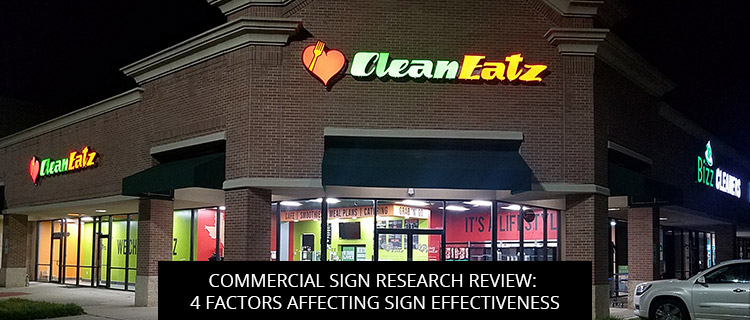Commercial Sign Research Review: 4 Factors Affecting Sign Effectiveness

In today’s post, we review key findings from 4 different sign studies to help you design better commercial sign systems.
Read on to 4 simple ways to make commercial signs more effective, without significantly altering your existing design, or call (972)-428-3200 to book a commercial sign consultation in Carrollton, TX straight away.
4 Factors Affecting Commercial Sign Effectiveness In Carrollton, TX
- Visual clutter—One study conducted by the Transportation Research Record found that “the average detection distances for signs decreased from 110 ft with minimum visual noise to 60 ft with high levels of visual noise” (Akagi et al., 1996). Put simply, the busier the space around your sign, the harder it is for consumers to see. Visual clutter can refer to rival signage, but also to the business owners’ own colorful product displays or decor.
To make your commercial signage more effective, try to find a location without visual noise or clutter. Reorganizing your store space costs nothing at all, and creating a dedicated display space could pay dividends.
- Font serifs—In typography, a serif is a small line or stroke running off the edge of letters in certain serif typefaces, as we see with Times New Roman and In a seminal study by Vision Research, researchers Arditi & Cho (2005) found that visual acuity is improved when serif fonts are used in place of sans-serif fonts, although reading speed was unaffected. Accordingly, if you’re trying to optimize your commercial sign copy, you might want to use a serif font. Don’t worry—it’s not as limiting as it sounds. We have a huge selection of serif fonts, and if you’re set on a sans-serif option, we’ve got plenty of other ways to crank up the conspicuity.
- Font style—In one study comparing the effectiveness of solid fonts and outline fonts, researchers Arditi et al. (1997) determined that visual acuity “was worse for outline fonts than for solid fonts,” and that outline character needed to be 1.8-times larger than solid characters in order to achieve equivalent legibility.
Of course, upsizing isn’t the only way to make outline fonts work, if they’re a part of your design vision. Get in touch with our team to learn more.
- Motion—Dynamic content, like that which appears on digital commercial sign displays, draws the eye like no other. In another study by Transportation Research Record, researchers Beijer et al. (2004) found that commercial signs with dynamic content received “twice as many glances as non-active ones.”
If you want to explore your option for dynamic commercial sign content, get in touch with our team.
Book A Free Commercial Sign Consultation In Carrollton, TX
When you’re ready to start building better commercial sign systems, we’re here to help. We carry all the most popular commercial sign types; we have plenty of experience and a 5-star Google rating; and our in-house design team can bring any vision to life.
To get a free quote on any commercial sign project, you can:
- Call (972)-428-3200
- Fill out the quick contact form on our website
- Email info@signgraphicsandgraphics.com
- Drop by our commercial sign shop at 1313 Valwood Parkway, Suite 324, Carrollton, TX 75006
References
Akagi, Y., Seo, T., and Motoda, Y. (1996). Influence of visual environments on visibility of traffic signs. Transportation Research Record, 1553, 53-58.
Arditi, A., and Cho, J., (2005). Serifs and font legibility. Vision Research, 45, 2926-2933.
Arditi, A., Liu, L., and Lyn,, W., (1997). Legibility of outline and solid fonts with wide and narrow spacing. Trends in Optics and Photonics.
Beijer, D., Smiley, A., and Eizenman, M. (2004) Observed driver glance behavior at roadside advertising signs. Transportation Research Record, 1899, 96-103.
Back
